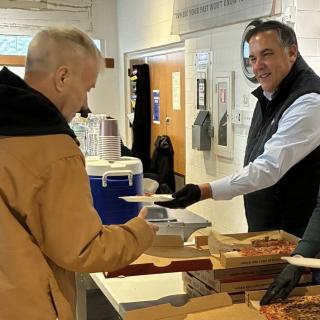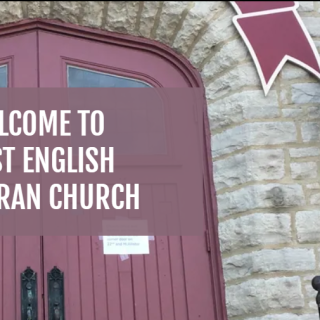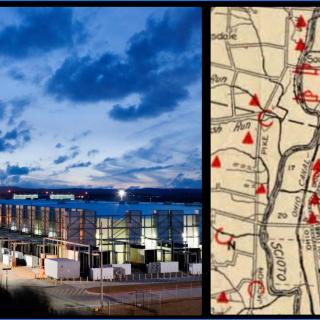Food Deserts. The definition by Merriam-Webster is “an area where little fresh produce is available for sale.” In rural areas and urban areas alike, food deserts are a concerning problem in communities everywhere. Columbus is not immune to food deserts. Communities like the South Side and Franklinton are stepping up to bring fresh produce to their inner-city neighborhoods.
On April 17, residents and stakeholders of the Near East Side packed together in the Community Room of Poindexter Place for a meeting on the “State of Retail” for that neighborhood.
The idea of a grocery store in the Near East Side has been a long soap opera unfolding, since the launch of Partners for Achieving Community Transformation (PACT) in 2012. In 2013, the original blueprint proposal from PACT called for a grocery store on Broad Street, between Ohio and Champion. However, after vocal opposition from Near East Area residents, and guidelines that were cited in the City’s 2005 Near East Area Plan on commercial zoning, that idea was scrapped.
“To have a (grocery) store on Broad Street, between Downtown and James Road is simply not gonna happen,” Near East Area Commissioner Dana Moessner said at the community meeting. Moessner cited the Zoning Issues on the Broad Street corridor as one of the reasons why. Broad Street is one of the two Near East Side corridors that has a high volume of traffic of 20,000 cars a day, with Main Street being the other in the Near East Side.
The 2013 PACT Blueprint, according to ColumbusUnderground.com, called for retail at the intersection of Champion and Mount Vernon Avenues. However, Bryan Brown, Chief Operating Officer of the Central Ohio Metropolitan Housing Authority, refutes that claim. At the April 17 meeting, Brown stated that the Carl Brown site was slated to be re-developed into mixed use housing. Brown added that a major market would not be coming to the Near East Side. “The world is changing. We’ll never get a big box market to come here. It’s just not going to happen.”
At that April 17 meeting, many residents that attended the meeting had more questions than answers about the state of retail for the Near East Side. “The Number One request in the (2013 PACT) Blueprint was an anchor grocery store,” said Near East Side resident Calvin Hairston. “Anyone can identify Carl Brown. The older folks (in the neighborhood) can tell you where every grocery store was,” Hairston added.
There is a “Catch-22” for retail in any urban core. Density, residents, and supportable income are required in a neighborhood for there to be viable retail. Once those pieces are put into place, the developers can make their move. This has worked for urban cores like the Short North and Clintonville. It has not worked so much for communities such as Linden, which saw their only big box grocery store, the Kroger at the Northern Lights Shopping Center close in January.
According to Chris Boring, the CEO of Boulevard Strategies, per capita income is one of the big hurdles for the Near East Side. Boring presented his fact findings from a study of the Near East Side at the April 17 meeting. Boring mentioned that the average per Capita Income for the Near East Side is less than one-third ($ 18,832) than that of Columbus as a whole ($ 65,041).
The Mount Vernon Avenue corridor has not had a success of keeping a supermarket in recent years. In September 1978, when Mount Vernon Plaza opened, there was a grocery store that was the anchor to the shopping center. According to WOSU’s Columbus Neighborhoods 2011 documentary on The King-Lincoln District, that anchor supermarket at the Mount Vernon Plaza lasted only eight months. The Carl Brown IGA, which was the first Black-owned grocery store in Columbus, when it opened in 1937, closed in 2007. The store building was razed in 2015.
“Carl Brown (Supermarket) was the soul of the community,” Hairston said. “When Carl Brown IGA left, the lifeline of this community left. This is reality.” The Near East Side as a whole, only has a Save-a-Lot and Kroger, both on East Main Street, as the only grocery stores that sell fresh produce within the Near East Side neighborhood boundaries.
While the Near East Side residents and stakeholders will continue to meet and have ongoing discussions about the possibility of retail in their community, Franklinton and the South Side have already beat the Near East Side to the punch, when it comes to landing a fresh produce market. In February, the Church for All People on Parsons Avenue opened a fresh produce market at an old Drive-Thru at the corner of Parsons and Whittier Street. This Summer, the Lower Lights Christian Health Center is slated to open Jubilee Market, a fresh market located next to their clinic on West Broad Street in Franklinton.



